PATTERN OF MENSTRUAL IRREGULARITY IN CHRONIC KIDNEY DISEASE (CKD) PATIENTS IN TERTIARY CARE HOSPITAL
DOI:
https://doi.org/10.71000/3w37wg75Keywords:
Amenorrhea, chronic kidney disease, dialysis, menstrual irregularities, menometrorrhagia, oligomenorrhea, reproductive healthAbstract
Background: Chronic kidney disease (CKD) profoundly affects multiple physiological systems, including the reproductive system, leading to hormonal imbalances that disrupt menstrual cycles. Women with CKD frequently experience menstrual irregularities such as amenorrhea, oligomenorrhea, and menometrorrhagia, which are exacerbated as kidney function declines. These disturbances not only impact fertility but also contribute to anemia, osteoporosis, and reduced quality of life. Understanding the prevalence and associated factors of menstrual irregularities in CKD patients is essential for improving patient management and outcomes.
Objective: To determine the prevalence and pattern of menstrual irregularities among female CKD patients and to identify associated demographic and clinical factors.
Methods: A descriptive cross-sectional study was conducted at the Department of Nephrology, PIMS Hospital, Islamabad, from August 1, 2024, to January 15, 2025. A total of 140 female patients aged 14 to 45 years with CKD, irrespective of etiology, were enrolled. Patients with a history of postmenopausal status or pre-existing gynecological disorders were excluded. Menstrual irregularities were assessed through structured interviews and medical record evaluations. Data were analyzed using SPSS version 25.0, with qualitative variables presented as frequencies and percentages, and quantitative variables expressed as mean ± standard deviation. The chi-square test was applied, considering a p-value of ≤0.05 as statistically significant.
Results: The mean age of participants was 30.64 ± 8.86 years. Only 26.4% maintained a normal menstrual cycle, while 37.1% had amenorrhea, 22.1% had oligomenorrhea, and 14.3% had menometrorrhagia. Stratification analysis showed that polycystic ovarian syndrome (p=0.015), cerebrovascular accident (p=0.006), and smoking (p=0.041) were significantly associated with menstrual irregularities, while other demographic and clinical variables, including age, dialysis status, and hypertension, were not statistically significant.
Conclusion: Menstrual irregularities are highly prevalent among female CKD patients, with amenorrhea being the most common disorder. PCOS, cerebrovascular disease, and smoking were identified as significant contributing factors. Routine reproductive health assessments and targeted interventions should be integrated into CKD management to address these concerns and improve patient outcomes.
Downloads
Published
Issue
Section
License
Copyright (c) 2025 Asmat Ullah, Muhammad Sajid Rafiq Abbasi, Muhammad Jawad, Muhammad Afnan Ullah Shah, Waqar Zia , Aqsa Rahat (Author)

This work is licensed under a Creative Commons Attribution-NonCommercial-NoDerivatives 4.0 International License.







